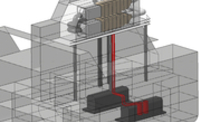ESTUDIO DE DISEÑO CONCEPTUAL PARA DESARROLLO MARINO
BACKGROUND
To meet new International Maritime Organisation rulings being introduced from 2012, vessels travelling within 200 nautical miles of shore will need to cut their fuel sulphur content by 98%.
OSL were engaged to develop new technology that can be fitted to existing ships and vessels to meet the new regulations.
The technology addresses the treatment of industrial air pollution sources by using state of the art process modelling applications. It has been designed for industrial sites, oil and gas platforms, power stations as well as marine and shipping requirements.
The project utilised a chemical modelling package to understand the materials requirements for chemical and thermal resistance.
PROJECT OVERVIEW
The scope of work included the development of a novel design concept for a ship exhaust stack quench, scrubber and plume abatement system. The design was developed on the basis of the client stated business objectives for a system that was easy to install within the constraints of an existing ship.
Specialised modelling software was used to create the heat and mass balance and the determine the system pressure drops.
OSL worked in conjunction with the client’s mechanical design team to create a scrubbing system with a compact footprint, used non-exotic materials and had minimal back pressure. The models were created to give a basis of design before being revised to incorporate mechanical design features and include the optimisation of the scrubber spray configurations.
Working closely with component vendors, their standard types were used in the equipment design.
KEY ASPECTS OF DELIVERY
- Rapid deployment of a close knit, multi-discipline, full-time team with relevant and ample experience of environmental projects
- Assessment of complex Regulatory outcome requirements
- Our ability to be flexible in providing quick responses to the Client's requirements
- Innovative design with in-house process and chemistry modelling technology
- Design capability for project delivery using dynamic flow modelling for gas and fluid streams.
- Sensitive information control and distribution both to and from OSL with regular coordination meetings Client’s technical team
CLEVER THINKING
The system layout was designed to fit within an existing ship configuration for ease of retrofitting. The design used standard heat balance calculations to reduce the operating temperature in the cooling sections which enabled a much lighter and more cost effective material to be selected instead of specialist alloys. This resulted in a much cheaper system that did not require specialist fabrication techniques and was able to use standard sized materials of construction.
BENEFITS TO CLIENT
- Business Technology Development through innovative process design
- New Technological Sales Offering technically validated to meet the demands of the new regulations
- A system designed with specific benefits to the end user
